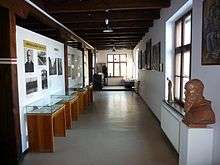Museum of St. Maximilian Kolbe "There was a Man"
 Interior of the museum | |
| Established | August 1998 |
|---|---|
| Location |
Niepokalanów, 96-515 Teresin, Poland |
| Type | religious, historical and missionary |
Coordinates: 52°12′16″N 20°25′15″E / 52.20444°N 20.42083°E
| Wikimedia Commons has media related to Museum in Niepokalanów. |
Museum of St. Maximilian Kolbe "There was a Man" (Polish: Muzeum św. Maksymiliana "Był człowiek") - is a museum, located in Niepokalanów monastery in Poland. Dedicated to the life and work of father Maximilian Kolbe, evangelization activity of Niepokalanów, and the Franciscan missions throughout the world.
Founding of the museum
The museum is located in one of the old buildings in Niepokalanów, where there used to be a laundry and a carpenter's workshop. The exhibition, which takes three rooms, was created by the employees of the Museum of the town of Pabianice. Now it's opened to visitors every day from 8.00 to 18.00.
6 August 1998 two compartments of the museum were opened to the public and blessed by card. Józef Glemp, who expressed his hope that the new exhibition will be a good catechesis, showing the visitors a shortest path to God. A month later, 20 September 1998, the museum was extended and a third compartment (missionary) was open by Franciscan bishop Jan Wilk, working in Brazil mission.
Exhibitions
In the first compartment a visitor in welcomed by the statue of St. Maximilian, made of bronze by the Italian sculptor Roberto Joppolo of Viterbo. The statue was blessed by Pope John Paul II in October 1982 during the ceremony of canonization of St. Maximilian Kolbe.
In the second part a visitor can see pre-war photographs and exhibits with explanations concerning the life and activity of the founder of Niepokalanów - St. Maximilian - since his childhood, through youth, studies, Japan mission until building a large publishing monastery, called Niepokalanów. The third room presents collection from the Franciscan missions in the world, offered mostly by the missionaries working in Japan, Brazil, Zambia, Peru, Kenya or Tanzania.
There are some peculiar pieces in this collection:
- a portrait of St. Maximilian made from post stamps;
- dried piranhas and skin of exotic snake;
- an image of the Mother of God woven from cereal grains.
Photo gallery

St Maximilian's room (replica in museum) 
Main entrance to the museum 
Compartment with African collection 
The beginnings of the monastery (photos)
Further reading
- Niepokalanów. Pilgrimage and tourist guide, red. fr. Roman Soczewka OFMConv. Wydawnictwo ZET, Wrocław 2004, ISBN 83-7364-185-8
- The monastery of Niepokalanów. English version of the monastery's official site
- O. Mariusz Paczóski, 70 lat Niepokalanowa (Seventy years of Niepokalanów). Wydawnictwo Ojców Franciszkanów, Niepokalanów 1999, ISBN 83-87638-14-5 (book in Polish language)
- Niepokalanów monastery. Basilica, panorama, museum - travel information
- Miasto Niepokalanej (City of the Immaculate - art. in Polish language), p. 216-219, in: Rycerz Niepokalanej (The Knight of the Immaculate) nr 7-8/2010, Niepokalanów, ISSN 0208-8878 (article in Polish language)